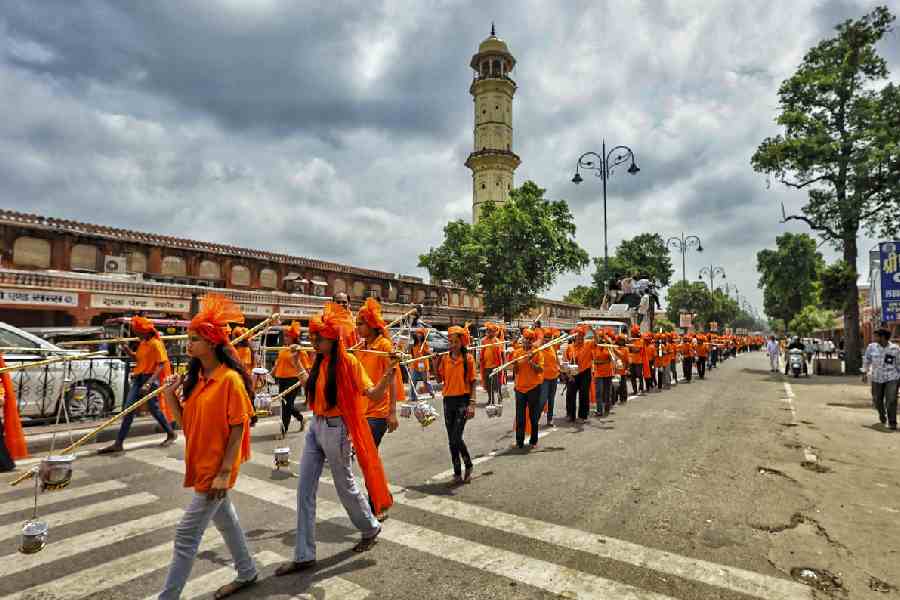-

Bina Masaley Ka Murg
Some days ago, when Old Delhi was just about to break its Ramzan fast, I decided that I had to go and meet some of my old bawarchi friends in the area. So, I landed up there to find that the cooks had started frying and grilling all kinds of delicious stuff for the evening iftar. I pottered around a bit and then went to an old crony to try out a freshly fried snack, which is called lukhmi in some parts of India. This looks a bit like the north Indian gujia or the Bengali chandrapuli. It is, however, not a sweet, but a samosa-like savoury filled with spicy keema.
In Delhi, the counterpart of lukhmi is simply called keema samosa and is usually available during the period of Ramzan. In Hyderabad, it is known as lukhmi — which is derived from the word luqma, which means a morsel — and is a veritable part of the city's street food. A bite of this, and you can tell that the city which takes pride in its nawabi cuisine is equally ecstatic about its street food.
If you are planning a visit to Hyderabad and are adventurous about food, I would suggest that you spend an evening or two in the lanes near the Charminar to try out some of the street food delicacies. 'The Hyderabad street food is a combination of Arab, Andhra and Mughlai cuisines,' says Rakesh Prasad, the executive sous chef of The Suryaa New Delhi.
What makes its street food particularly delightful is the combination of southern and northern influences. Ingredients that go into southern sauces (til or sesame, for instance) are used in combination with spices to give the food its own identity, chef Prasad, who spent some years in Hyderabad, holds.
The street food is varied, and the influence of the royal kitchens on the dishes is evident in the use of dried fruit and nuts. In Pratibha Karan's wonderful book Hyderabadi Cuisine, her Hyderabadi husband Vijay Karan (a former Delhi Police Commissioner) mentions in the introduction that the food has more non-vegetarian than vegetarian dishes, which explains why the street food is essentially meaty too.
-

Lukhmi
But, of course, that doesn't mean there are no vegetarian snacks. It has quite a few of those — including something called tootak, which is a semolina-crusted dumpling filled with cottage cheese and potatoes. 'In Hyderabad tootaks are baked over live charcoals in a specially designed contraption called lagan,' Pratibha writes.
Another vegetable street food item is aloo ke garlay, a local version of the batata vada. There is also booti samosa, which is a fried pastry with a green gram filling.
But the real delights, as far as I am concerned, are the meat dishes. 'Haleem (a thick broth of cracked grains and meat), paya (trotters) and zaban (tongue) are particularly popular and are eaten on the streets with all kinds of naans and other breads,' says Mandaar Sukhtankar, the executive chef of The Park Hotel Hyderabad. 'There are shops that only sell naans,' he adds.
One aspect of Hyderabadi street food that I find particularly interesting is the tradition of naming dishes after the tools that are used for cooking. You get a delicious kabab called patthar ka gosht, in which thin slivers of meat are grilled over a heated granite slab. Then there is taatee kabab, which refers to a stand made of interwoven strips of metal on which the meat is placed directly. The kababs are cooked on the taatee over a charcoal fire.
One of the dishes that chef Prasad has been labouring over is bina masaley ka murg — chicken cooked without too many spices, though a pinch of garam masala, caraway seeds and green cardamom figure in the recipe. The main ingredients are curd, cream, ginger and garlic paste, peeled almonds and saffron.
Street food, I have always believed, is the soul of any cuisine. And increasingly the people's fare is becoming the preferred fare for fine diners in the country. More power to the people, I say.
Mutthi Ke Kebab
(serves 4)
Ingredients:
• 500g keema • 1 tbs chopped ginger • 1 tbs chopped garlic • 1 tsp red chilli powder • 1 tsp chopped green chillies • 1 tsp coriander leaves • 2 crushed red chillies • 1 tsp cumin seeds • 1 tsp roasted coriander seeds cup cooked basmati rice • 100g roasted channa powder • 1 finely sliced onion • 1 tbs fried and crushed onions • 1 tsp garam masala • 1 egg • 200g ghee or refined oil • salt and pepper to taste
Method:
Add salt and pepper to the minced meat. Mix with channa powder, chopped ginger and garlic, red chilli powder and crushed red chillies. Add the rice and the spices, chopped onion, green chillies and coriander and the beaten egg. Mix well. Add the fried onions. Leave for 10 minutes. Now place a small portion in the palm of your hand and close your fist. Keep the fist-shaped raw kabab aside, and repeat with the rest of the minced meat. Fry the kababs in hot oil till golden brown. Serve hot with onion rings.











